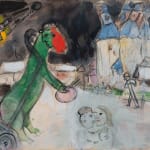

Marc Chagall
Le Cheval à la palette dans une rue de village (Horse with a palette in a village street), 1926-27 'circa'
Signed 'Chagall' (lower right)
Gouache, watercolor and pencil on paper
24.1 by 30.5 cm (9½ by 12 in.)
69405
© 2023 Artists Rights Society (ARS), New York / ADAGP, Paris
Executed circa 1926-27. The authenticity of this work has been confirmed by the Comité Marc Chagall. Executed while he was living in Paris, Le Cheval à la palette dans une...
Executed circa 1926-27. The authenticity of this work has been confirmed by the Comité Marc Chagall.
Executed while he was living in Paris, Le Cheval à la palette dans une rue de village evokes Chagall’s nostalgic vision of his home in Vitebsk, a primarily Jewish town in the western region of the Russian Empire that was drastically affected by the aftermath of World War I and the Russian Revolution. Painted as a dreamscape and loosely rendered as if the city were fading in the artist’s memory, the composition shows the under-drawing of the buildings as the figures in the foreground fade into the cloudy blue street. The horse, whose head bears the double image of a man in profile, stands on its back legs and holds a palette, acting as the creator of the scene and possibly Chagall himself.
Executed while he was living in Paris, Le Cheval à la palette dans une rue de village evokes Chagall’s nostalgic vision of his home in Vitebsk, a primarily Jewish town in the western region of the Russian Empire that was drastically affected by the aftermath of World War I and the Russian Revolution. Painted as a dreamscape and loosely rendered as if the city were fading in the artist’s memory, the composition shows the under-drawing of the buildings as the figures in the foreground fade into the cloudy blue street. The horse, whose head bears the double image of a man in profile, stands on its back legs and holds a palette, acting as the creator of the scene and possibly Chagall himself.

